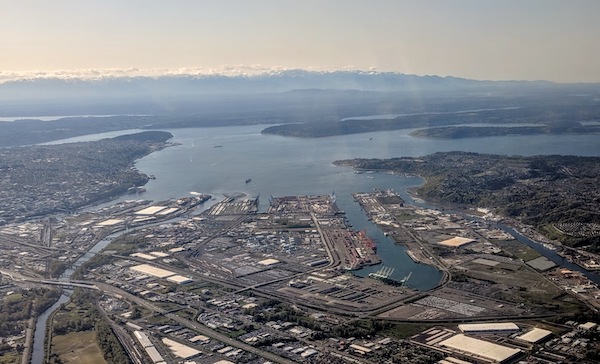
How The Area 11 Summer Salmon Fishery Got Hijacked …
I’m literally at a loss for words trying to explain the reasoning behind why WDFW paused salmon fishing off Tacoma with 81 percent of the hatchery Chinook quota still available – 2,734 keepers! – but just 17 percent of the sublegal encounter limit left in play.
I mean, it actually hurts my head.

WDFW kicked me in the noggin earlier today with the stunning why (and thus the wherefores) behind yesterday afternoon’s rule change notice that takes effect in Marine Area 11 tomorrow, July 15.
Honestly, I just should have used my email program’s suggested response – “not really” – in replying to the agency honcho who asked if I wanted to chat about it over the phone, and then gone on my merry way to proofread some more layouts ahead of my press deadline.
But here we are, so let’s give this a shot.
I GUESS I SHOULD START BY defining what a sublegal Chinook is, as it applies to Area 11: a Chinook less than 22 inches, the minimum size of a retainable hatchery fish.
Given that Puget Sound is a vast estuary where young salmon rear, that size restriction essentially is meant to protect juvenile Chinook either before they brave the vast North Pacific or grow into the blackmouth fishery, such as it is these days anyway.
As anglers of the inland sea are all too familiar with, recent years have seen the rise of managing state fisheries around sublegal encounters, unmarked (e.g., unclipped, natural-origin or wild fish) encounters, legal-size encounters – after all, the region’s Chinook are listed as threatened under the Endangered Species Act – plus longer standing ones like catch quotas and catch guidelines on the coast.
But as it turns out, that sublegal encounter limit also protects jacks – randy male Chinook that return to their hatchery or home river a year ahead of schedule and generally can be retained in freshwater if they’re at least 12 inches long.
A few years ago now I found myself on Richmond Beach in Shoreline gnashing my teeth at the hatchery jack at my feet. Already beginning to color up a bit – and very, very clearly not one of the shiny juvenile Chinook that occasionally chase down Buzz Bombs (or typically smaller trolled offerings) – it was an inch or so too small to keep, so back it went into Puget Sound.
Something along those lines appears to be taking place in Area 11, where “a higher than expected percentage of sublegal jacks have been caught in the test fishery” over the past week to 10 days, according to the WDFW official who delivered today’s boots to mein cabeza.
True, scale samples still need to be run to officially confirm that those catches are in fact jacks, as well as figure out where they might have been headed, but the number of precocious males this summer in these particular waters apparently is something state managers haven’t seen before and it will have warped this fishery after just eight angling days.
I don’t know that anybody really thought about this when sublegal encounter limits became a thing, but essentially what we’re seeing this summer is that one of Pugetropolis’s most preeminent Chinook fisheries – storied Clay Banks, Owen Beach, the Slagpile, Dalco Point, Point Defiance Boathouse rental boats, you name it – is being managed by a jack encounter limit.
That shouldn’t be. That should not be.
Shakers are one thing; jacks are something else entirely.
But bound by preseason encounter limit agreements, WDFW has to pause salmon season until perhaps a work-around inside the overall Chinook impacts approved by federal overseers might be found.
I’m actually somewhat pessimistically cautiously optimistic about that remote possibility; extra crossed fingers and toes might help. Or not. Maybe that’ll jinx it. On second thought, don’t cross anything and bide your time fishing for salmon elsewhere – Areas 5, 6, 7, 9, 10, 12 (south of Ayock) and 13; the Tulalip Bubble; Westport – it’s en fuego; Chelan Falls or Brewster.
As for Area 11, faced with 3,209 of 3,845 available sublegal encounters already accounted for, I can understand why WDFW’s sportfishing advisors reportedly wanted to preserve the remaining 636 for August, when the bulk of the adult hatchery kings plow through these waters and pink salmon and coho begin to arrive as well. There’s a wee bit of product ready for those fish.
Like I told the WDFW manager, I don’t envy their job in the least. I do believe they’re trying to eke out as much opportunity as possible under all the constraints, the increasing restrictions, and whatnot.
But with what happened last summer to the south in Area 13, I just hope they have this one right; it would be interesting to know if tribal comanagers are running any of their new test fisheries, meant to replicate sport catches, in these same waters, and what their results might be showing.
After I hung up with WDFW, I started wondering about how to address this apparently unique situation – about how jack catches might need to be accounted for in sublegal encounter agreements at future North of Falcon salmon-season negotiations, or dealt with in the saltwater fishing regulations.
And I also wondered if maybe this was actually good news disguised as bad – strong numbers of jacks might mean a stronger-than-forecast adult run this year, or maybe it’s a portent for 2024?
Sigh, if only we had some magic way to update Puget Sound runs in-season.
*2022 Lower Columbia fall Chinook anglers nod in very vigorous agreement as they stab their fingers repeatedly at pages 32-33 of the recently published WDFW-ODFW 2023 joint staff report*
And that is going to have to be all the time I have for this.

